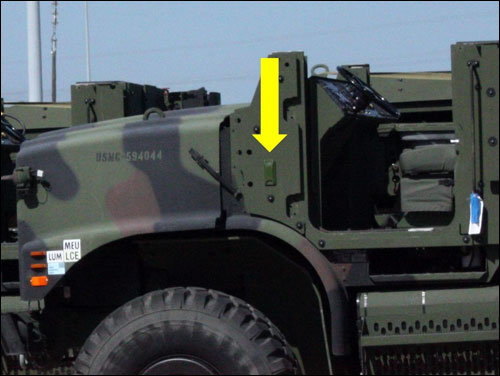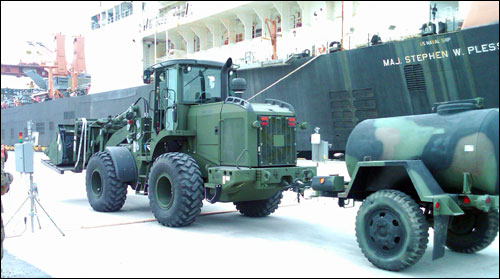Jun 25, 2010As part of its efforts to improve asset visibility and equipment accountability, the U.S. Marine Corps' Blount Island Command has evaluated passive RFID technology, and is now applying passive RFID tags to the equipment transported on what are known as maritime prepositioning ships (MPS).
Blount Island, located near Jacksonville, Fla., is responsible for maintaining all the equipment and supplies aboard MPS vessels. Currently, the command depends on bar-coded labels and active RFID tags to track all MPS cargo and equipment. In 2009, the command began attaching passive ultrahigh-frequency (UHF) RFID EPC Gen 2 tags to 20-foot-long steel cargo containers and vehicles.
The U.S. Military Sealift Command operates 16 ships that are specially configured to strategically position supplies for the Marine Corps and the U.S. Navy. These MPS vessels are loaded with a variety of Marine Corps and Navy equipment and supplies, including tanks, howitzers, trucks, ammunition, food, hospital equipment, petroleum products, supplies and spare parts. The vessels are then strategically positioned throughout the globe, ready for rapid delivery ashore where and when required.
Approximately five MPS vessels pass through Blount Island per year. The loading of each one, known as back-loading, typically takes eight working days. For the past 20 years, the Marine Corps has employed 2-D bar-coded labels on some larger items, such as vehicles and ISO containers, to track their movement from their arrival at the pier through the loading process. In compliance with a 2004 U.S. Department of Defense (DOD) mandate, the Marines have also been utilizing active 433 MHz RFID tags for in-transit visibility. However, says Lyle G. Layher, the head of Blount Island Command's MPS Plans Management Branch, the active RFID solution provided limited tracking capability.
"The DOD-mandated solution [of active RFID tags] is not a good fit for the MPS community's more precise and reliable data demands for asset visibility," he says. The tags' batteries often have died or been damaged by the time troops attempted to read the tags, he explains. In addition, the reading of bar-coded labels is time-consuming and error-prone, due to its reliance on manual scans by military staff members.
On the other hand, passive RFID technology performance has been gaining in read range and reliability. Passive RFID tags are now available that can read reliably at a range of 100 feet, Layher points out. Two years ago, Blount Island Command decided to conduct a test of passive UHF Gen 2 RFID tags in partnership with Alien Technology, which provided ALX-9010 passive reader portals and consulting services, and is overseen by Stanley Associates, the command's on-site support contractor. Blount Island Command established its Systems Integration and Training Facility (SITF) to manage the testing of passive EPC Gen 2 UHF RFID tags.
Last year, after testing 30 different passive RFID tags, the command attached the best-performing tag—Omni-ID's MaxHD tag—to cargo containers and vehicles loaded onto one of the MPS vessels, the USNS Maj. Stephen W. Pless. Those tags were read as the USNS Pless was loaded and then tested again in Korea in April 2010, when the ship was offloaded for a military exercise. Blount Island officials brought the readers to Korea to track vehicles as they were off-loaded and re-loaded. Assets tags were read during each phase of the exercise (for example, during off-loading, staging, maintenance and distribution) to their respective operational areas, and for re-loading aboard the Pless.
The system employs Intermec handheld readers and Alien mobile and fixed readers, as well as a software system known as Integrating Placement and Registration of Identified Materials and Equipment (IPRIME), which Blount Island Command created by enhancing existing software. By using the passive RFID tags, Layher says, the command is gaining higher accuracy and reliability rates compared with existing inefficient systems, such as 2-D bar-coded labels and active Savi Technology tags.
Savi Technology points out that it provides the DOD, including Blount Island Command, with more than just 433 MHz active RFID tags. The company supplies an end-to-end solution that can accommodate data from all types of technologies, including bar-coding, passive and active RFID tags, GPS and satellite communications—contingent on the application. "Savi's active tag technology been successfully deployed by the U.S. Department of Defense since the mid-1990s," says Mark Nelson, a Savi spokesman, "because of its long read ranges (300-plus feet), nearly 100 percent accuracy, ruggedized and battle-tested form factor, storage capacity (128 kilobytes of programmable memory) and omnidirectional read capabilities—all of which requires less reader infrastructure than other forms of RFID."
Blount Island Command's cargo containers bear multiple ID tags and labels. At approximately the same time that the command was launching the passive RFID test, the DOD began mandating that each cargo container and vehicle have an Item Unique Identification (IUID) label, with a Unique Item Identification (UII) number printed in text and bar-code format. Also attached to every container or vehicle is a separate bar-coded label, with a different serial number printed as a bar code, used by an older tracking system that has not yet been phased out. Blount Island Command opted to link the item's UII number to the new MaxHD tag by writing the UII number to the tag's memory at the time that it was attached to the container or vehicle. Because the older bar-code system—which links to data about the container or vehicle—is still in use as well, each piece of equipment currently still has a bar-code label, as well as the printed IUID label and a passive EPC Gen 2 RFID tag. What's more, to meet Department of Defense requirements for containers, the active tag also remains.
The passive RFID tagging process (which was used for the tests involving the USNS Pless and is now being utilized for other vessels as well) begins with the attachment of an Omni-ID MaxHD, a tag embedded in a rigid protective plastic casing that measures 140 by 100 by 14 millimeters (5.5 by 4 by 0.6 inches). As each new container or vehicle is added to the IPRIME system, a passive RFID tag is permanently attached to it via adhesive, as well as the bar-coded label, active tag and IUID label. Employees use an Intermec CK61 handheld computer fitted with an Intermec IP30 RFID interrogator and capable of reading or scanning the passive RFID tag, the bar-coded label and the IUID dot-matrix label. After the item's UII is scanned, that number is written to the passive RFID tag, and the data is sent to the IPRIME software on the back-end MDSSII system via a Wi-Fi connection, where the RFID tag's unique ID number and the UII are linked together and stored.
To read the passive RFID tags of the containers and vehicles being loaded onto the vessel, the SITF created two mobile reader portals with Alien ALX-9010 readers at the checkpoints leading to the vessel. The passive RFID readers must be mobile in order to accommodate the loading of containers and vehicles onto the vessel.
An ALR 9900 reader at a permanent portal was installed at the entrance gate to the pier's staging lot (where containers and vehicles are delivered to the pier for shipping) with two outdoor Poynting PTCH A0025 antennas. As tagged vehicles and cargo containers pass through a gate at which the permanent portal was deployed, the tag is read and its status is updated in the back-end system, thereby indicating that particular container or vehicle has arrived at the pier. The tag is then read by a mobile portal deployed at either of two other locations: at the ship's ramp, or at the site at which containers and vehicles are lifted onto or off of the pier via a crane.
For the test involving the USNS Pless, 254 containers were tagged, 241 were read and 13 were missed. In addition, 452 vehicles and other large pieces of equipment were tagged, and 419 of those tags were read. Officials conducted a failure analysis on the tags that were not read, and determined that in most instances, the tag was not placed in the appropriate location. These errors were identified and corrected prior to the ship's departure from Blount Island.
In Korea, at the Port of Mokpo, the tags could be read effectively at a distance of about 20 feet, at a chokepoint set up there. Layher says the commander in Korea was well aware of Blount Island's passive RFID initiative. "His endorsement made it easy for Blount Island to send a technical assistance and advisory team and hardware to the Korean port," he states, "to track the arrival and movement of cargo off the vessel."
In Korea, the readers were installed to read the MaxHD tag of each cargo container or vehicle as it was off-loaded from the vessel and transported to a staging area. In the future, Layher says, he hopes to see RFID reader hardware travel with the vessel, so that it would not have to be shipped from Blount each time a vessel docked, with the intention of off-loading the cargo. To date, the command has used MaxHD tags on containers and vehicles for four vessels, now at sea. It plans to use the tags on containers and vehicles for a fifth ship, scheduled to be serviced in July.
Based on the success of the tests conducted at Blount Island and in Korea, the command is continuing to place passive RFID tags on containers and vehicles for MPS.
"Our goal is to continue to put the tags out there," Layher states. "We've demonstrated that it's an awesome way to collect data." In the meantime, he says, the military is required to continue attaching active RFID tags to containers, though Layher predicts that the rule will someday change.



